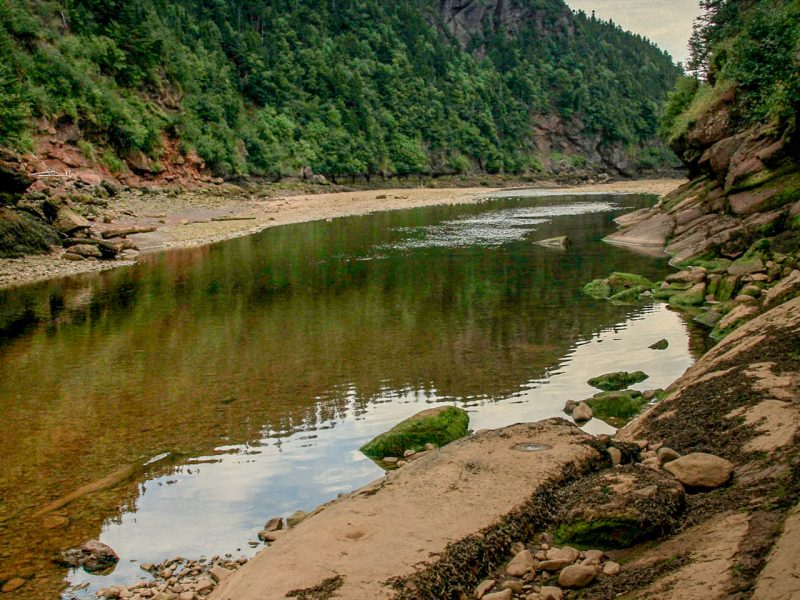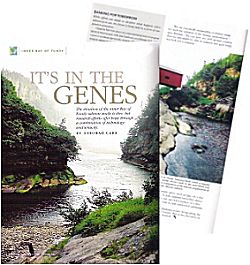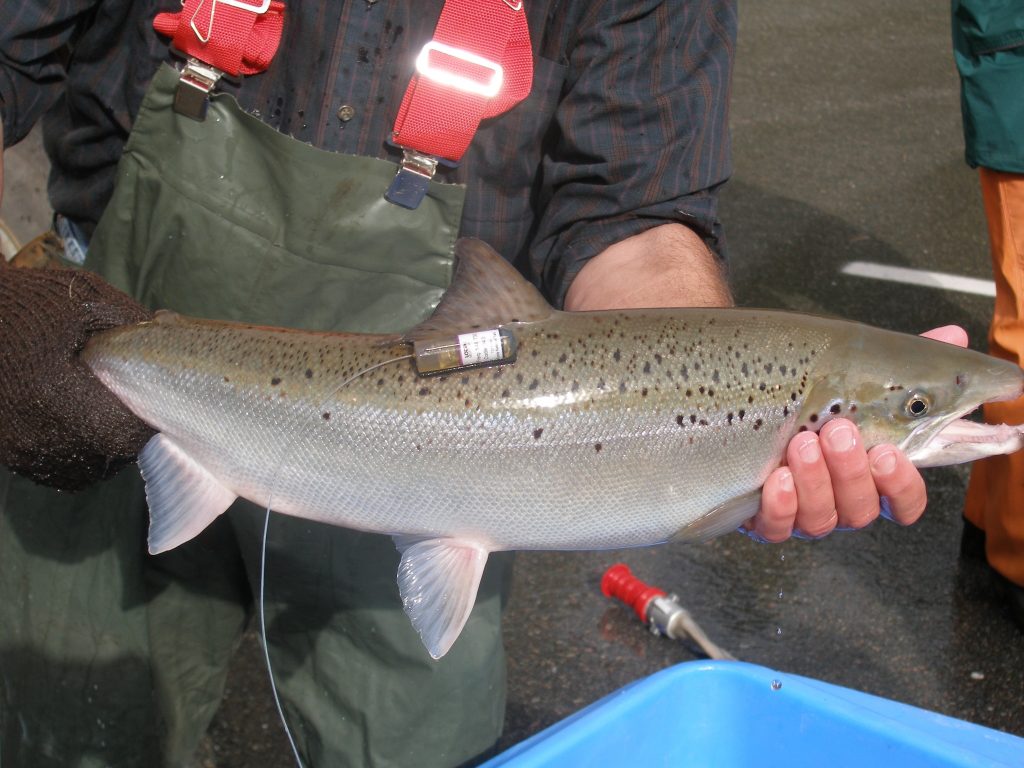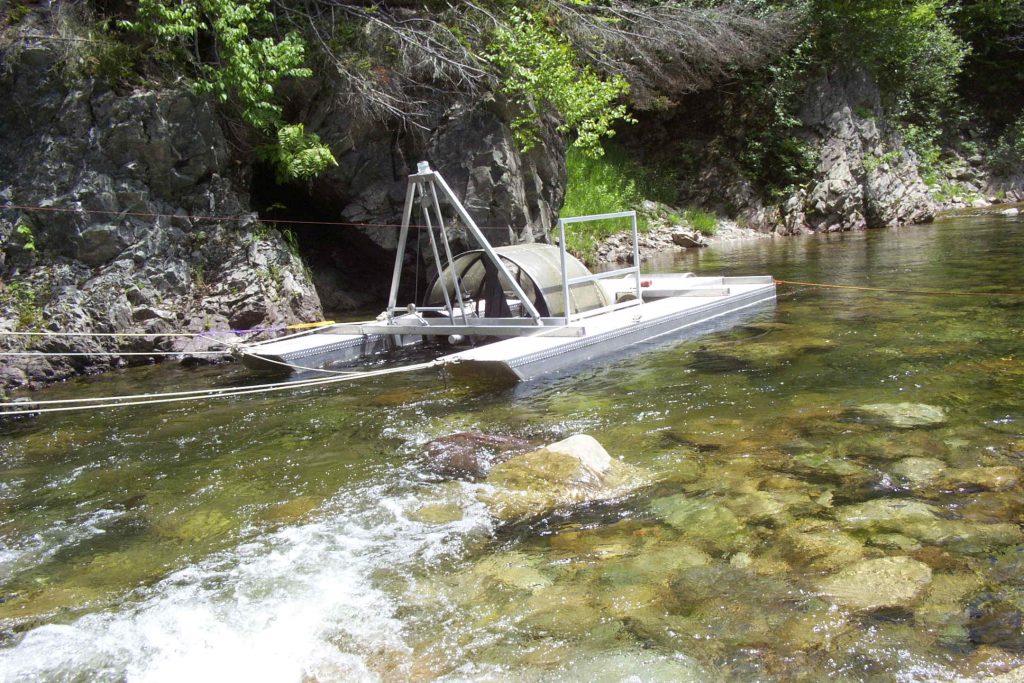
It’s in the Genes

excerpted from Atlantic Salmon Journal, Winter 2004 / photography and text © Deborah Carr 2004
Birthed in an era that predates the Ice Age, the waters of the Upper Salmon River in Fundy National Park have tumbled over massive rock outcroppings, carved deep pools, then meandered along more gentle grades to the Bay of Fundy for untold millennia.
Standing on the bank of the river named for its once plentiful bounty, park eco-scientist Renee Wissink exhibits a curious mingling of sadness and optimism. His quiet gaze traces the river’s current where clear water persistently polishes a riverbed of smooth multi-coloured rubble, the geological remnants of ancient mountains that once could rival the Canadian Rockies. The late summer sun filters through a canopy of green, casting dancing shadows on the rippled surface.
This should be salmon heaven.
“We’ve been told that in the not so distant past you could walk along this river in places like Jiggers Rock, near the Black Hole, and could see upwards of 100 adults in the holding pool,” Wissink says, his eyes scanning the shallows for movement amongst the pastel pebbles. “This time of year, in this river, you should be seeing adult salmon in these pools. Now you will not see any.”
Today, these steeply incised valley walls are thick with balsam fir, red spruce, yellow birch, maple, and poplar, but just over a century ago, the same craggy cliffs clung to only a few remnants of the forest’s wealth, the rest having been toppled and flushed through the river for a logger’s profit.
It was man’s quest for the spruce along these rivers that first destroyed the salmon habitat in the 19th century with spring logging drives scouring the gravel river bottom, dams presenting barriers to migration, and sawmills depositing great amounts of sawdust to clog the waterways. Years later, man intervened to right his wrongs. Fishways were constructed, dams partially opened, sawdust piled on land, and the hardy salmon returned to spawn once more. But then in the mid-1980’s, they began to disappear.
When the Inner Bay of Fundy salmon population was listed by COSEWIC as an endangered species in 2001, it opened the door for the creation of a recovery strategy and an intensive two year population assessment. The results were frightening. “We are in an extinction vortex,” says Wissink. “When populations get so low that the problems seem to compound and they spiral down to extinction, there becomes a point when you cannot stop it. We are almost there.”
While all the Inner Bay of Fundy rivers are experiencing critically low returns of adult spawning salmon, monitoring efforts failed to detect any wild returning adults within the last two years in the Upper Salmon and Point Wolfe Rivers.
The discovery placed these rivers in a crisis situation.
“If we can get our adults back, we can grow salmon in these rivers without too much difficulty,” says Wissink. “But the problem has been losing the fish out to sea and not coming back as spawning adults. Finding the problem is a needle in a huge haystack and far beyond our jurisdiction. Our big contribution to the recovery is to establish the in-river gene banks. To capture what is left of the genetic diversity in both rivers and hold them in a state of suspended animation.”
Utilizing resources at the Bedford Institute of Oceanography and the Mactaquac Biodiversity
Facility, FNP embarked on a complex program involving DNA fingerprinting, captive rearing, gene banking, and cryopreservation; one that is designed to bypass the marine phase in the salmon life cycle and preserve the remnant population until the cause of marine mortality is discovered and rectified.
“This is cutting-edge conservation biology”, says Wissink.
In August and September park staff, assisted by recovery team members from Fort Folly First Nations, use a technique called electrofishing, which is effective in briefly stunning large groups of the river’s fish so they can be safely scooped and transported to Mactaquac. There each is tagged and tissue samples collected for genetic analysis and research. Some remain in captivity, while the rest are returned to the river.
Using the science of DNA fingerprinting – like that seen on the popular TV show “CSI” – scientists at the Bedford Institute gain valuable information about kinship, geographic location of origin, and even some aspects of the history of a particular population. In a sense, this means that each fish captured is genealogically inventoried and identified. This information is used to develop specific pedigree mating plans to maintain the existing families and increase the genetic diversity of the species.
DNA fingerprinting on captured salmon revealed that within the Upper Salmon River, only eight distinct families existed with over half belonging to a single family. The Point Wolfe River contained only nine families. “Within these rivers, the MVEP (minimum viable effective population) does not exist,” states Wissink bluntly. “What this means is that, without drastic intervention, within two or three years they could be extirpated.” MVEP is the baseline of genetic diversity needed for the species to self-sustain in a healthy manner. Without it, the species will inbreed itself to extinction.

Location transmitters affixed to salmon. (Photo copyright © Deborah Carr)
Translated to numbers, the Upper Salmon and Point Wolfe Rivers need 375 to 400 returning adults for the species to become self-sustaining.
The general recovery program is two-pronged in its approach. First, captive live gene banks at Mactaquac contain representatives from the existing identified families as a ‘safety net’ population. Using wild mates whenever possible, the maximum number of genetic families are reared in balance so that large families will not displace the smaller ones.
Secondly, in-river live gene banks are maintained in the river environments using fertilized eggs in incubation baskets, juveniles, and some adult fish from the captive breeding plan. Juveniles mature in the natural environment, but are captured in the spring after the smoltification process that scientists believe imprints their natal river and prepares them for salt-water exposure. A rotary screw-like trap called a smolt wheel is positioned near a river barrier so fish attempting to migrate are, instead, safely funnelled into a cage for transport to Mactaquac.
Kept in controlled ponds at the biodiversity facility, these fish are exposed to the approximate feeding and temperature changes they might experience in the Bay of Fundy. Spawning is orchestrated according to the mating plan, and the majority of eggs are placed in the river to hatch. The rest are hatched in captivity; some of these are released as unfed fry into the river system, others are kept to stock the captive gene bank population.
Once adults have been spawned twice in captivity, they are released to reproduce again naturally and continue the instinctive emigration to sea unhindered. In this way, a percentage of fish are being born and raised in the wild.
Each gene bank is a backup of the other. Should a family disappear from the river environment, the genes are protected in the captive fish. As well, should some catastrophic event wipe out the captive families, each can be reconstructed using the wild fish from the river.
“The goal of the live gene bank is to sustain the salmon populations in the face of high marine mortality so we have something to work with in the future,” says Wissink.
In addition, more intensive research and strategies are also being explored at Fundy. Wild parr collected in 1998 from the Big Salmon River, near St. Martins, were raised to adults in the controlled ponds at Mactaquac, crossed under pedigree, then the progeny raised from eggs to mature adults in captivity. Last year, these first generation grilse were released into the Point Wolfe River to ascertain if fish bred and raised in captivity, with no river imprint, would significantly contribute to an in-river gene bank. Twenty-four of these were acoustically tagged in order to track movement and provide additional research data.
“This year we will release our own fish, captured as smolt in Upper Salmon River, back into that same watercourse. They should be properly imprinted. Then we can compare and contrast the two to see which is the more successful recovery strategy,” says Wissink.

Smolt wheel on Upper Salmon River, Fundy National Park (Photo copyright © Deborah Carr)
The ongoing process of DNA fingerprinting brought forth some interesting recent conclusions. The genetic diversity of the Fundy rivers is continuing to narrow, which means many of the remaining fish are the result of the mating of very few adults.
“The other problem is the introgression of aquaculture genes. Clearly what we are seeing is a population with a narrow genetic diversity that has been cross-breeding with (escaped) aquaculture fish,” says Wissink. He says even though the use of European stock in North American aquaculture has been prohibited for many years, the genes are still showing up in wild fish. And while there is evidence of this European ancestry in Upper Salmon stock, so far the Point Wolfe population seems untainted. “Probably what we have to do now is screen the aquaculture fish out of the program, and supplement the Upper Salmon fish with Point Wolfe and Big Salmon River salmon to broaden that basis.”
Additional aspects of the program include ongoing collections of fish from the rivers to contribute to mating plans, gene banking and cryopreservation of sperm. Cryopreservation may be used to reintroduce genetic variation in the future and, if necessary, to counteract negative genetic changes that may occur due to captivity.
Later, we returned to the Upper Salmon so I could view it with new eyes of appreciation.
“We’re essentially suspending evolution while we seek the solution in the marine environment,” sums up Wissink.
“It is a really bold statement to think we can do that, but in these days of molecular biology it allows us to accomplish this in a whole different way. We can now say with greater comfort that we just might be able to achieve this goal while we look for a solution.”
On the banks of the Upper Salmon, Wissink’s optimistic words speak of science and technology. But on a soft summer day, in a heavenly place such as this, with sulphur butterflies dancing like angels on the sun speckled surface of a free flowing river, they also offer hope
Atlantic Salmon Journal, Winter 2004 / photography and text © Deborah Carr 2004



